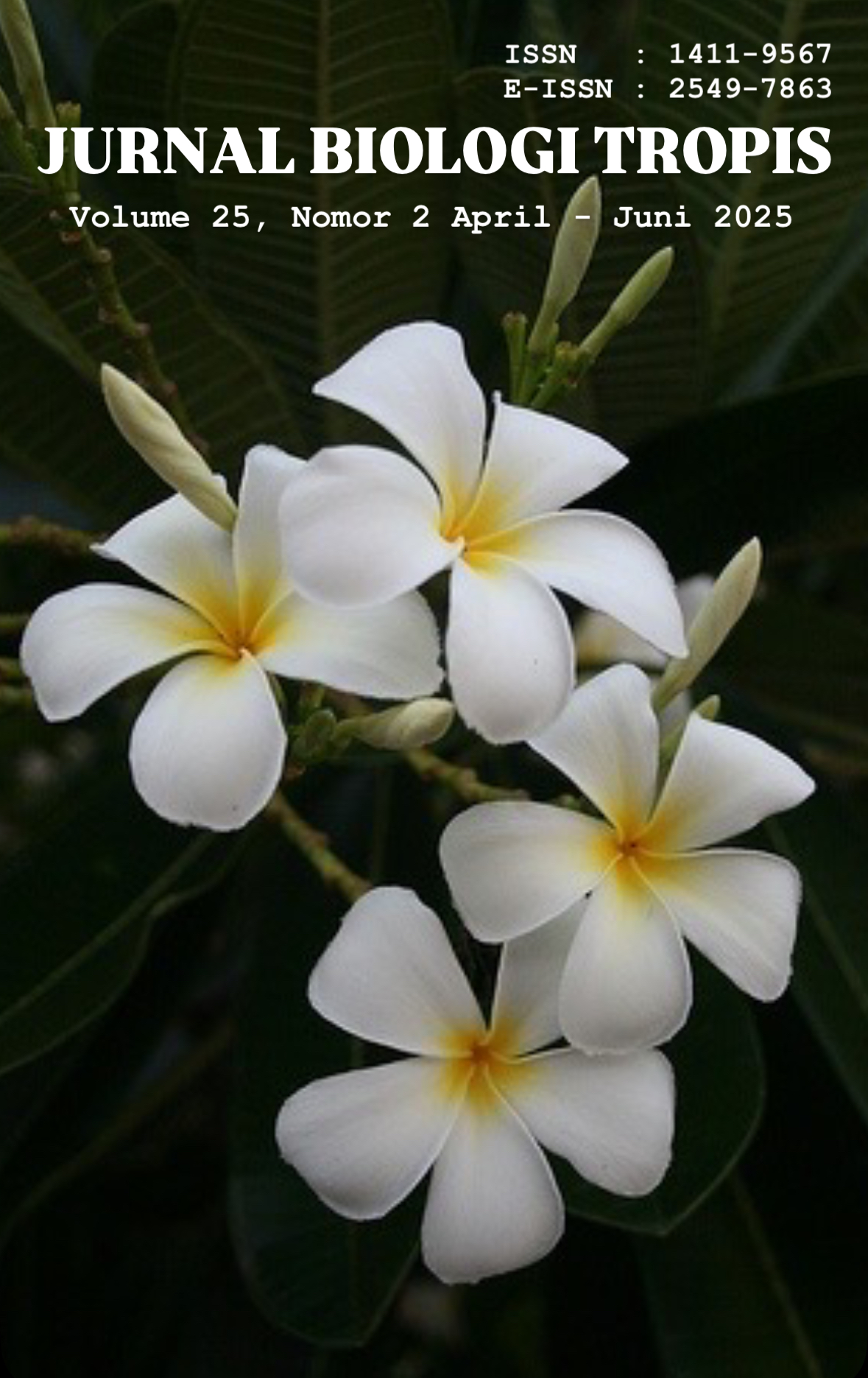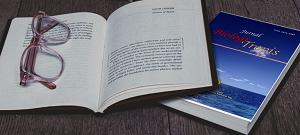Effect of Miana Leaf Extract (Plectranthus scutellarioides (L.) R.Br.) as a Natural Fungicide against Colletotrichum capsici on Chili Plants
Authors
Sally Khoirunisa , Intan Poespita Windiyani , Yulianty YuliantyDOI:
10.29303/jbt.v25i2.8621Published:
2025-04-21Issue:
Vol. 25 No. 2 (2025): April-JuniKeywords:
Anthracnose, Colletotrichum capsici, Chili plants (Capsicum annuum L.), miana leaf extract (Plectranthus scutellarioides L.).Articles
Downloads
How to Cite
Downloads
Metrics
Abstract
Anthracnose disease caused by the fungus Colletotrichum capsici causes rotting of ripe chili fruits and causes a decrease in chili production up to 80%. Excessive use of synthetic pesticides can cause problems for humans and the environment. Therefore, as an alternative, natural/vegetable pesticides that are more environmentally friendly can be used. Miana leaves contain flavonoids, tannins, saponins and steroid compounds that are known to be responsible for pesticide effects on plants. The purpose of this study was to determine the effectiveness of miana leaf extract as a natural fungicide and the best concentration in inhibiting the growth and development of Colletotrichum capsici fungus that causes anthracnose disease of chili plants (Capsicum annuum L.). The research method used a completely randomized design (CRD). The treatment used in the study was the concentration of miana leaf extract. The treatment used 5 concentrations of miana leaf extract (Plectranthus scutellarioides L.), namely: 0%, 5%, 10%, and 15% and 20%. Each treatment was repeated 5 times. The parameters observed were the intensity of C. capsici fungus attack, plant height, plant wet weight, and plant dry weight. The results showed that the application of miana leaf extract (Plectranthus scutellarioides L.) had no effect on each parameter, namely the intensity of C.capsici fungal attack, plant height, plant wet weight, and plant dry weight.
References
Artantyo, L.D.B, Fatimawali, Datu, O. S. (2022). Photochemical Screening and Toxicity Testing Of Red Miana leaf (Coleus hybridus) Ethanol Extract Using Brine Shrimp Lethality Test (BSLT) Method. Phamarmacon-Program Studi Farmasi, Fmipa, Universitas Sam Ratulangi, 7(2021), 1–14.
Chen, C., Qian, Y., Chen, Q., Tao, C., Li, C., & Li, Y. (2011). Evaluation of pesticide residues in fruits and vegetables from Xiamen, China. Food Control, 22(7), 1114–1120. https://doi.org/10.1016/j.foodcont.2011.01.007
Dyastuti, E. A., Nofiani, R., & Ardiningsih, P. (2013). Uji Organoleptik Cincalok dengan Penambahan Serbuk Bawang Putih (Allium sativum) dan Serbuk Cabai (Capsium Annuum L). Jurnal Kimia Khatulistiwa, 2(2), 70–73.
Kumar, R., Kranthi, S., Nitharwal, M., Jat, S. L., & Monga, D. (2012). Influence of pesticides and application methods on pest and predatory arthropods associated with cotton. Phytoparasitica, 40(5), 417–424. https://doi.org/10.1007/s12600-012-0241-5
Kusumawati, D. E., & Istiqomah. (2022). Pestisida Nabati sebagai Pengendali OPT (Organisme penganggu Tanaman). In Madza Media.
Lubis, R. M. F., Situmorang, Z., & Rosnelly, R. (2021). Autoregressive Integrated Moving Average (ARIMA-Box Jenkins) Pada Peramalan Komoditas Cabai Merah di Indonesia. Jurnal Media Informatika Budidarma, 5(2), 485. https://doi.org/10.30865/mib.v5i2.2927
Makatempuge, A. J., Fatimawali, & Lebang, J. S. (2023). Antibacterial Acitvity Test of Ethanol Extract of Mayana Leaf (Coleus atropurpureus Benth) On Streptococcus Mutans and Salmonella Typhimurium. Pharmacon, 12(1), 9–18. https://doi.org/https://doi.org/10.23917/ujp.v3i1.309
Manullang, H. F., Marbun, V. E., & Nurjannah, I. S. (2020). Uji Efektivitas Air Perasan Daun Jeruk Nipis (Citrus aurantifolia Swingle.) sebagai Pestisida Nabati terhadap Lalat Buah. Jurnal Inovasi Kesehatan Masyarakat, 2(1), 121–126. https://doi.org/https://doi.org/10.36656/jikm.v2i1.444
Neneng, L., & Saraswati, D. (2019). Reklamasi Lahan Kritis Bekas Penambangan Emas Menggunakan Metode Bioremediasi Dan Fitoremediasi. EnviroScienteae, 15(2), 216. https://doi.org/10.20527/es.v15i2.6955
Permatasari, S. C., & Asri, M. T. (2021). Efektivitas Ekstrak Ethanol Daun Kirinyuh (Eupatorium odoratum) Terhadap Mortalitas Larva Spodoptera litura. LenteraBio : Berkala Ilmiah Biologi, 10(1), 17–24. https://doi.org/10.26740/lenterabio.v10n1.p17-24
Phoulivong, S. (2012). Cross infection of Colletotrichum species; a case study with tropical fruits. Current Research in Environmental & Applied Mycology, 2(2), 99–111. https://doi.org/10.5943/cream/2/2/2
Pratama, M. (2017). Identifikasi Atribut Aroma dan Rasa Rempah Dengan Profiled Test. Jurnal Agroindustri Halal, 3(2), 126–132. https://doi.org/10.30997/jah.v3i2.903
Prita, F, A, Koesriharti, S. (2013). Pengaruh Penambahan Unsur Hara Mikro (Fe dan Cu) Dalam Media Paitan Cair dan Kotoran Sapi Cair Terhadap Pertumbuhan dan Hasil Bayam Merah (Amaranthus tricolor L.) Dengan Sistem Hidroponik Rakit Apung. Jurnal Produksi Tanaman, 1(3), 48–58. https://doi.org/https://doi.org/10.21176/protan.v1i3.30
Renate, D., Pratama, F., Yuliati, K., & Priyanto, G. (2014). Model Kinetika Degradasi Capsaicin Cabai Merah Giling Pada Berbagai Kondidi Suhu Penyimpanan. Jurnal Agritech, 34(03), 330. https://doi.org/10.22146/agritech.9462
Satria, Wardati, & Khoiri. (2015). Pengaruh Pemberian Kompos Tandan Kosong Kelapa Sawit dan Pupuk NPK Terhadap Pertumbuhan Bibit Tanaman Gaharu (Aquilaria malaccencis). Jom Faperta, 2(1), 1–14. https://jom.unri.ac.id/index.php/JOMFAPERTA/article/view/7286
Solichatun, Endang, A., Mudyantini, W. (2005). The effect of water availability on growth and saponin content of Talinum paniculatum Gaertn. Biofarmasi Journal of Natural Product Biochemistry, 3(2), 47–51. https://doi.org/10.13057/biofar/f030203
Suharman, J., AR, T., & Rahmawati, R. (2022). Aplikasi Pemberian Pupuk Trichompos Terhadap Pertumbuhan dan Produksi Berbagai Varietas Cabai Kriting. PLANTKLOPEDIA: Jurnal Sains Dan Teknologi Pertanian, 2(1), 18–31. https://doi.org/10.55678/plantklopedia.v2i1.633
Suhartini, Suryadarma, IGP, Putu, B. (2017). Pemanfaatan Pestisida Nabati Pada Pengendalian Hama Plutella Xylostella Tanaman Sawi (Brassica juncea L.) Menuju Pertanian Ramah Lingkungan. Jurnal Sains Dasar, 6(1), 36. https://doi.org/10.21831/jsd.v6i1.12998
Sutriadi, M. T., Harsanti, E. S., Wahyuni, S., & Wihardjaka, A. (2020). Pestisida Nabati: Prospek Pengendali Hama Ramah Lingkungan. Jurnal Sumberdaya Lahan, 13(2), 89. https://doi.org/10.21082/jsdl.v13n2.2019.89-101
Syahira, O., Tanjung, S. A., & F, M. B. (2024). Formulasi Sediaan Sabun Padat Transparan Dari Ekstrak Etanol Daun Miana ( Coleusscutellarioides ( L .) Benth ) Sebagai Antiseptik Formulation of Transparent Solid Soap from Ethanol Extract of Miana Leaves ( Coleusscutellarioides ( L .) Benth ) as an Antis. 4(2), 1–6. https://doi.org/10.51849/j-bikes.v
Ta’dung, R, Tumbol R.A, Mudeng, J.D, Sinjay, J.S, Cyska, L. (2023). Pemanfaatan ekstrak daun miana (Coleus atropurpureus L. (Bent)) untuk meningkatkan respon imun benih ikan Nila (Oreochromis niloticus). AT-TAWASSUTH: Jurnal Ekonomi Islam, VIII(I), 1–19. https://doi.org/https://doi.org/10.35800/bdp.v11i2.47719
Triadiati T, Carolina, A. C., & . M. (2016). Induksi Pembentukan Gaharu Menggunakan Berbagai Media Tanam dan Cendawan Acremonium sp. dan Fusarium sp. Pada Aquilaria crassna. Jurnal Sumberdaya Hayati, 2(1), 1–6. https://doi.org/10.29244/jsdh.2.1.1-6
Wasiah, A. (2014). Uji efikasi ekstrak daun iler. Skripsi. Universitas Islam Negeri Syarif Hidayatullah Jakarta.
Windriyati, R. D. H., Tikafebianti, L., & Anggraeni, G. (2020). Pembuatan Pestisida Nabati Pada Kelompok Tani Wanita Sejahtera di Desa Sikapat. Dinamisia : Jurnal Pengabdian Kepada Masyarakat, 4(4), 635–642. https://doi.org/10.31849/dinamisia.v4i4.4137
Ziaulhaq, W., & Amalia, D. R. (2022). Pelaksanaan Budidaya Cabai Rawit sebagai Kebutuhan Pangan Masyarakat. Indonesian Journal of Agriculture and Environmental Analytics, 1(1), 27–36. https://doi.org/10.55927/ijaea.v1i1.812
License
Copyright (c) 2025 Sally Khoirunisa, Intan Poespita Windiyani, Yulianty Yulianty

This work is licensed under a Creative Commons Attribution 4.0 International License.

Jurnal Biologi Tropis is licensed under a Creative Commons Attribution 4.0 International License.
The copyright of the received article shall be assigned to the author as the owner of the paper. The intended copyright includes the right to publish the article in various forms (including reprints). The journal maintains the publishing rights to the published articles.
Authors are permitted to disseminate published articles by sharing the link/DOI of the article at the journal. Authors are allowed to use their articles for any legal purposes deemed necessary without written permission from the journal with an acknowledgment of initial publication to this journal.


























